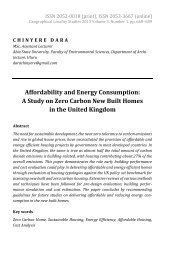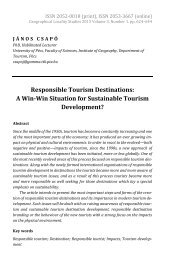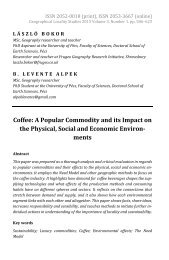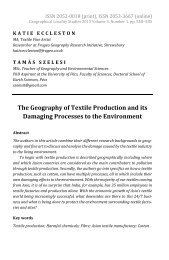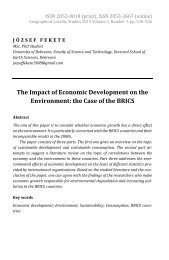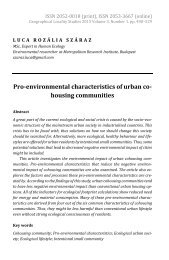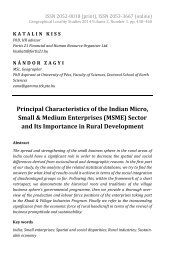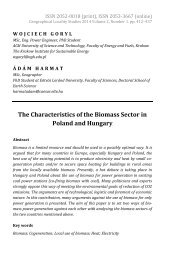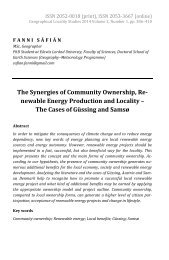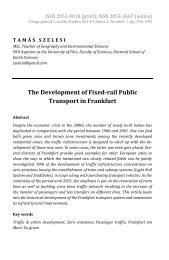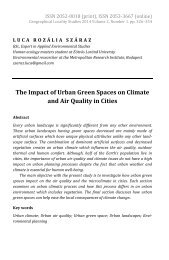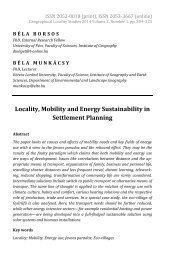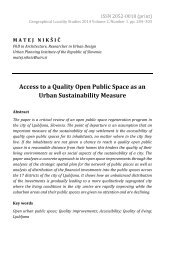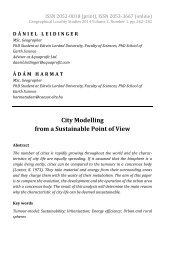Nándor Zagyi: Traditional Energy – Free Solutions for Ventilation and Air-Cooling in Arid Tropical Areas of Asia
Nowadays, more and more air-conditioning devices are installed to cool the inner spaces of dwelling and public buildings in the populous developing countries. Therefore, it is worth drawing attention to those traditional methods and architectural forms by which comfortable air conditions could be generated in the hot arid and semi-arid areas of the Planet.
Nowadays, more and more air-conditioning devices are installed to cool the inner spaces of dwelling and public buildings in the populous developing countries. Therefore, it is worth drawing attention to those traditional methods and architectural forms by which comfortable air conditions could be generated in the hot arid and semi-arid areas of the Planet.
Create successful ePaper yourself
Turn your PDF publications into a flip-book with our unique Google optimized e-Paper software.
ISSN 2052-0018 (pr<strong>in</strong>t)<br />
Geographical Locality Studies <strong>–</strong> June 2013, Volume 1, Number 1. pp. 5879.<br />
NÁNDOR ZAGYI<br />
MSc, PhD Student<br />
University <strong>of</strong> Pécs, Faculty <strong>of</strong> Sciences, Doctoral School <strong>of</strong> Earth Sciences<br />
zana@gamma.ttk.pte.hu<br />
<strong>Traditional</strong> <strong>Energy</strong> <strong>–</strong> <strong>Free</strong> <strong>Solutions</strong><br />
<strong>for</strong> <strong>Ventilation</strong> <strong>and</strong> <strong>Air</strong>-<strong>Cool<strong>in</strong>g</strong> <strong>in</strong> <strong>Arid</strong> <strong>Tropical</strong><br />
<strong>Areas</strong> <strong>of</strong> <strong>Asia</strong><br />
Abstract<br />
Nowadays, more <strong>and</strong> more air-condition<strong>in</strong>g devices are <strong>in</strong>stalled to cool the <strong>in</strong>ner<br />
spaces <strong>of</strong> dwell<strong>in</strong>g houses <strong>and</strong> public build<strong>in</strong>gs <strong>in</strong> the populous develop<strong>in</strong>g countries,<br />
ma<strong>in</strong>ly—with<strong>in</strong> <strong>Asia</strong>—<strong>in</strong> India <strong>and</strong> <strong>in</strong> Ch<strong>in</strong>a. The need <strong>for</strong> such devices<br />
contributes not only to the growth <strong>of</strong> municipal <strong>and</strong> public electricity consumption<br />
<strong>and</strong> emission <strong>of</strong> pollutants, but it is also responsible <strong>for</strong> a negative selfgenerat<strong>in</strong>g<br />
process: the more greenhouse gases are released—as a result <strong>of</strong> aircondition<strong>in</strong>g—the<br />
warmer our environment becomes. There<strong>for</strong>e, it is worth<br />
draw<strong>in</strong>g attention to those traditional methods <strong>and</strong> architectural <strong>for</strong>ms by which<br />
com<strong>for</strong>table air conditions could be generated <strong>in</strong> the hot arid <strong>and</strong> semi-arid<br />
areas <strong>of</strong> our Planet—with respect to this study <strong>in</strong> South <strong>Asia</strong>. We can f<strong>in</strong>d several<br />
examples <strong>of</strong> such solutions <strong>in</strong> India <strong>and</strong> <strong>in</strong> the Iranian Bas<strong>in</strong>, as well. Modern age<br />
architects have also started to discover the importance <strong>of</strong> these ancient methods<br />
<strong>and</strong> to apply them <strong>in</strong> their works. Although, widespread use <strong>of</strong> such techniques<br />
cannot be expected <strong>in</strong> the near future, the success <strong>of</strong> these <strong>in</strong>novative but low-key<br />
attempts achieved until now should be reported.<br />
Key words<br />
<strong>Air</strong> condition<strong>in</strong>g; <strong>Air</strong> pollution; Develop<strong>in</strong>g countries; <strong>Traditional</strong> air com<strong>for</strong>t<br />
improv<strong>in</strong>g; <strong>Traditional</strong> methods <strong>of</strong> architecture
Geographical Locality Studies 2013 Volume 1, Number 1<br />
1. The environmental <strong>and</strong> social effects <strong>of</strong> the spread<strong>in</strong>g <strong>of</strong> airconditioners<br />
The serious consequences <strong>of</strong> the <strong>in</strong>creas<strong>in</strong>g rate <strong>of</strong> <strong>in</strong>dustrial <strong>and</strong> energy<br />
production, motorisation <strong>and</strong>, closely related to them, population<br />
growth <strong>and</strong> urbanisation—such as the negative climate chang<strong>in</strong>g effects<br />
<strong>of</strong> greenhouse gases accumulated <strong>in</strong> the atmosphere—have<br />
ga<strong>in</strong>ed scientific certification <strong>in</strong> the last fifty years. The spread<strong>in</strong>g <strong>of</strong><br />
electric air-condition<strong>in</strong>g contributes greatly to the environmental<br />
damage occurr<strong>in</strong>g <strong>in</strong> the <strong>for</strong>m <strong>of</strong> air-pollution through the emission <strong>of</strong><br />
various gases <strong>in</strong> energy production or directly from the AC devices;<br />
although, this fact hardly has any impact on social awareness. The<br />
<strong>in</strong>creas<strong>in</strong>g need <strong>for</strong> these devices is well-marked by the turnover<br />
growth <strong>in</strong> the market <strong>of</strong> air conditioners that reached 13% between<br />
2010 <strong>and</strong> 2011. Meanwhile, the amount <strong>of</strong> energy consumed by air<br />
conditioners put <strong>in</strong>to the electrical system was 10 12 kWh/year (COX, S.<br />
2012). The total energy dem<strong>and</strong> <strong>of</strong> air-condition<strong>in</strong>g is naturally enhanced<br />
by the AC equipment <strong>of</strong> motor-vehicles through their excessive<br />
fuel consumption.<br />
It should be noted that global as well as regional aspects <strong>of</strong> the year<br />
by year observable consumption growth are conspicuous, as we have<br />
recently witnessed a remarkable spatial rearrangement <strong>in</strong> this regard,<br />
too. Nowadays, the “lead<strong>in</strong>g” role <strong>of</strong> the United States <strong>of</strong> America is still<br />
undoubted regard<strong>in</strong>g both the number <strong>and</strong> energy consumption <strong>of</strong> air<br />
conditioners put <strong>in</strong> operation. Moreover, the amount <strong>of</strong> electricity used<br />
<strong>for</strong> air-cool<strong>in</strong>g is higher than the whole current consumption <strong>of</strong> Africa;<br />
between the years <strong>of</strong> 1993 <strong>and</strong> 2005, this k<strong>in</strong>d <strong>of</strong> current use had doubled,<br />
until 2010 it <strong>in</strong>creased by 20%, moreover—<strong>and</strong> as a result <strong>of</strong><br />
additional energy need <strong>of</strong> vehicles <strong>and</strong> build<strong>in</strong>gs—almost 500 million<br />
tons more CO 2 has been emitted <strong>in</strong>to the atmosphere (COX, S. 2012).<br />
However, the advance <strong>of</strong> economically develop<strong>in</strong>g countries with high<br />
population is more <strong>and</strong> more evident <strong>in</strong> this field, as well. Among them<br />
is Ch<strong>in</strong>a where only <strong>in</strong> 2010 50 million air conditioners were sold.<br />
Accord<strong>in</strong>g to the unanimous belief <strong>of</strong> <strong>for</strong>ecasts, the number <strong>of</strong> climatised<br />
vehicles will have doubled by 2015, reach<strong>in</strong>g 100 million. Fur-<br />
59
<strong>Nándor</strong> <strong>Zagyi</strong><br />
thermore, by 2020 preced<strong>in</strong>g the USA, Ch<strong>in</strong>a will have become the first<br />
ranked <strong>in</strong> the use <strong>of</strong> electricity <strong>for</strong> air-cool<strong>in</strong>g purposes (COX, S. 2010),<br />
thus, by 2050 Ch<strong>in</strong>a will have been the most dom<strong>in</strong>ant state <strong>in</strong> current<br />
consumption <strong>for</strong> climatisation which, accord<strong>in</strong>g to long-term prognoses,<br />
will have risen tenfold on global level by that time (ISAAC, M. <strong>–</strong><br />
VUUREN, D. P. 2009). Consider<strong>in</strong>g the future, it is more <strong>and</strong> more certa<strong>in</strong><br />
that, simultaneously with the overstock<strong>in</strong>g <strong>of</strong> the local market, the<br />
develop<strong>in</strong>g, first <strong>of</strong> all South <strong>and</strong> Southeast <strong>Asia</strong>n countries—<strong>of</strong> which<br />
India already excels—follow<strong>in</strong>g Ch<strong>in</strong>a <strong>in</strong> the development <strong>of</strong> economy<br />
<strong>and</strong> <strong>in</strong> the rise <strong>of</strong> liv<strong>in</strong>g st<strong>and</strong>ards with some time lag will be the great<br />
consumers <strong>of</strong> the post-2020 period (MCNEIL, M. A. <strong>–</strong> LETSCHERT, V. E.<br />
2008). The <strong>in</strong>creas<strong>in</strong>g dem<strong>and</strong> <strong>for</strong> air conditioners <strong>in</strong> India has more<br />
reasons. On the one h<strong>and</strong>, it is a means <strong>in</strong>dicat<strong>in</strong>g the status symbol <strong>of</strong><br />
the vigorously exp<strong>and</strong><strong>in</strong>g <strong>and</strong> strengthen<strong>in</strong>g middle class; on the other<br />
h<strong>and</strong>, there are also real needs <strong>for</strong> AC devices because <strong>of</strong> the higher<br />
<strong>in</strong>door temperatures as a result <strong>of</strong> the new architectural design <strong>and</strong><br />
build<strong>in</strong>g materials. The latters have replaced the traditional ones<br />
which have been adapted to the local climatic characteristics. It is supported<br />
by the data accord<strong>in</strong>g to which the turnover <strong>of</strong> AC equipment<br />
has <strong>in</strong>creased by 17% <strong>in</strong> the last three years <strong>in</strong> India (DAHL, R. 2013).<br />
In connection with the environmental <strong>and</strong> economic effects <strong>of</strong> the<br />
spread<strong>in</strong>g <strong>of</strong> AC devices, some geographical relations worsen<strong>in</strong>g the<br />
problem should also be po<strong>in</strong>ted out. First <strong>of</strong> all, the economically develop<strong>in</strong>g<br />
countries are partly the most characteristic scenes <strong>of</strong> urbanisation<br />
<strong>and</strong> are predom<strong>in</strong>antly situated <strong>in</strong> the tropicalsubtropical regions<br />
<strong>of</strong> the Earth. It is conv<strong>in</strong>c<strong>in</strong>gly demonstrated by the fact accord<strong>in</strong>g<br />
to which 37 out <strong>of</strong> the world’s 50 most populous agglomerations—<br />
among them 14 are <strong>in</strong> Ch<strong>in</strong>a <strong>and</strong> <strong>in</strong> India—can be found <strong>in</strong> the develop<strong>in</strong>g<br />
world <strong>and</strong> the ones with the hottest climate (30 out <strong>of</strong> 50) with the<br />
exception <strong>of</strong> 3—hav<strong>in</strong>g their CDD (<strong>Cool<strong>in</strong>g</strong> Degree Days) <strong>in</strong>dex higher<br />
than 1000—are also located <strong>in</strong> this group <strong>of</strong> states (SIVAK, M. 2009),<br />
based on the country classify<strong>in</strong>g system <strong>of</strong> the International Monetary<br />
Fund (IMF ONLINE 2012). The CDD <strong>in</strong>dex is such a product <strong>of</strong> multiplication<br />
which is applied to express the rate <strong>of</strong> need <strong>for</strong> air condition<strong>in</strong>g,<br />
60
Geographical Locality Studies 2013 Volume 1, Number 1<br />
<strong>and</strong> one <strong>of</strong> its parts is the sum <strong>of</strong> the number <strong>of</strong> days with more than<br />
18°C (64.4°F) mean temperature, while the other part is constituted by<br />
add<strong>in</strong>g up the value doma<strong>in</strong> <strong>of</strong> each day’s mean temperature exceed<strong>in</strong>g<br />
18°C (64.4°F).<br />
Consider<strong>in</strong>g the environmental effects <strong>of</strong> the spread<strong>in</strong>g <strong>of</strong> electric<br />
climatisation, the type <strong>of</strong> the primary energy resources applied to generate<br />
electricity is not negligible either. In this regard, we should also<br />
take <strong>in</strong>to account the spatial features <strong>of</strong> the types <strong>of</strong> fossil fuels <strong>and</strong><br />
their roles <strong>in</strong> energy production, as they contribute significantly to the<br />
<strong>in</strong>crease <strong>of</strong> exhaust emissions, but <strong>in</strong> a different degree. The difference<br />
between the material characteristics <strong>of</strong> coals <strong>and</strong> hydrocarbons—<br />
especially that dur<strong>in</strong>g the oxidation <strong>of</strong> the latter, the amount <strong>of</strong> carbon<br />
gases emitted is fewer—has a well perceptible impact on environmental<br />
degradation. This rise becomes particularly significant if Ch<strong>in</strong>a <strong>and</strong><br />
India are picked out <strong>of</strong> the group <strong>of</strong> develop<strong>in</strong>g countries on the basis<br />
<strong>of</strong> their population <strong>and</strong> economic potential as well as their climatic<br />
characteristics. In these two countries, about 2 / 3 <strong>of</strong> the electricity is<br />
generated <strong>in</strong> coal-fired power stations (PROBÁLD, F. 2008; SZEGEDI, N. <strong>–</strong><br />
WILHELM, Z. 2008).<br />
As a result <strong>of</strong> the grow<strong>in</strong>g need <strong>for</strong> air cool<strong>in</strong>g, more <strong>and</strong> more<br />
greenhouse gases are released <strong>in</strong>to the atmosphere which, <strong>in</strong> connection<br />
to global warm<strong>in</strong>g, starts a self-generat<strong>in</strong>g process that <strong>in</strong>creases<br />
the amount <strong>of</strong> electricity used <strong>for</strong> climatisation <strong>of</strong> build<strong>in</strong>gs <strong>and</strong> the<br />
rate <strong>of</strong> air pollution onwards. The decrease <strong>of</strong> energy needed <strong>for</strong> heat<strong>in</strong>g,<br />
which is ma<strong>in</strong>ly based on hydrocarbons, is unable to compensate<br />
<strong>for</strong> the strengthen<strong>in</strong>g <strong>of</strong> this environmental impact. The population<br />
growth <strong>and</strong> the improvement <strong>of</strong> <strong>in</strong>come conditions <strong>of</strong> the develop<strong>in</strong>g<br />
world have considerably contributed to this, as well. On the other<br />
h<strong>and</strong>, this also means that the cumulated energy need <strong>and</strong> greenhouse<br />
effect <strong>of</strong> heat<strong>in</strong>g <strong>and</strong> cool<strong>in</strong>g is go<strong>in</strong>g to <strong>in</strong>crease further <strong>in</strong> the com<strong>in</strong>g<br />
decades (ISAAC, M. <strong>–</strong> VUUREN, D. P. 2009).<br />
The <strong>in</strong>creased dem<strong>and</strong> <strong>for</strong> electricity—the degree <strong>of</strong> which is well<br />
demonstrated by the 2.0<strong>–</strong>2.5-fold rise <strong>of</strong> electrical energy used <strong>in</strong> the<br />
hottest months <strong>in</strong> Delhi between 2000 <strong>and</strong> 2009—is endanger<strong>in</strong>g, not<br />
61
<strong>Nándor</strong> <strong>Zagyi</strong><br />
only the environment but also the safe <strong>in</strong>dustrial <strong>and</strong> public power<br />
supply (WOLFRAM, C. 2012). For <strong>in</strong>stance, India suffers from a day-today<br />
lack <strong>of</strong> energy <strong>in</strong> some places <strong>and</strong> times. Even 16-hour long power<br />
cuts can happen (COX, S. 2012) with which AC devices contribute to<br />
<strong>in</strong>creas<strong>in</strong>gly burden<strong>in</strong>g the electrical grid.<br />
2. Possible solutions to mitigate the environmental impact <strong>of</strong> air<br />
condition<strong>in</strong>g<br />
If we wish to <strong>in</strong>sist on the present habitual air-com<strong>for</strong>t level <strong>of</strong> cooled<br />
<strong>in</strong>terior rooms also <strong>in</strong> the future <strong>and</strong> we would like to assure the cool<strong>in</strong>g<br />
<strong>of</strong> <strong>in</strong>ner spaces by air conditioners solely, there are theoretically<br />
two possible ways <strong>of</strong> solution strengthen<strong>in</strong>g each other's effect to keep<br />
back the concentration growth <strong>of</strong> greenhouse gases emitted <strong>in</strong>to the<br />
atmosphere. One <strong>of</strong> them is to <strong>in</strong>crease the energy efficiency <strong>of</strong> the<br />
devices <strong>and</strong> the other one would be the larger scale use <strong>of</strong> renewable<br />
energy resources.<br />
The success <strong>of</strong> attempts to <strong>in</strong>crease efficiency depends on the development<br />
<strong>and</strong> spread<strong>in</strong>g <strong>of</strong> the optimum refrigerant <strong>of</strong> AC devices. In<br />
the most widely used <strong>and</strong> presently operat<strong>in</strong>g air conditioners, hydrocarbon<br />
derivatives perta<strong>in</strong><strong>in</strong>g to Hydr<strong>of</strong>luorocarbons (HFCs) are the<br />
materials applied as refrigerants <strong>in</strong> the cool<strong>in</strong>g cycle. These were<br />
bound to replace the refrigerants <strong>of</strong> the older equipment namely<br />
Chlor<strong>of</strong>luorocarbons or Freon (CFCs, HCFCs) deplet<strong>in</strong>g the stratospheric<br />
ozone layer, after the so-called Montreal Protocol. The latter is an<br />
<strong>in</strong>ternational agreement that constra<strong>in</strong>s their production <strong>and</strong> circulation<br />
<strong>of</strong> them which came <strong>in</strong>to <strong>for</strong>ce <strong>in</strong> 1989. Although, the decreas<strong>in</strong>g<br />
process <strong>of</strong> the ozone layer concentration has been managed to stop<br />
<strong>and</strong> even reversed, the greenhouse effect <strong>of</strong> these chemicals (both the<br />
CFCs <strong>and</strong> the HCFCs) is still considered as a huge problem. When compar<strong>in</strong>g<br />
the GWP (Global Warm<strong>in</strong>g Potential) <strong>of</strong> these hydrocarbon<br />
derivatives with that <strong>of</strong> CO 2 , the <strong>for</strong>mer can be greater by 2<strong>–</strong>3 orders <strong>of</strong><br />
magnitude. Their role <strong>in</strong> global warm<strong>in</strong>g is less significant than that <strong>of</strong><br />
other greenhouse gases, but only because they are released <strong>in</strong> much<br />
lower concentrations <strong>in</strong>to the atmosphere.<br />
62
Geographical Locality Studies 2013 Volume 1, Number 1<br />
In the spotlight <strong>of</strong> these facts, it is undoubted that the key factor <strong>in</strong><br />
the modernisation <strong>of</strong> AC devices is the replacement <strong>of</strong> old refrigerants<br />
by new ones with much lower GWP. But it seems that such an attempt<br />
will not lead to real solutions <strong>in</strong> a short term. With the <strong>in</strong>crease <strong>of</strong> efficiency<br />
also <strong>in</strong> view, their technical efficiency is much lower than that <strong>of</strong><br />
HFCs, not to mention their other problematic characteristics like <strong>in</strong>flammability,<br />
toxicity, ozone deplet<strong>in</strong>g effect <strong>and</strong> so on. Besides, the<br />
positive environmental impact <strong>of</strong> some possible improvements <strong>in</strong> energy<br />
efficiency would not prevail because <strong>of</strong> the <strong>in</strong>crease <strong>in</strong> the CO 2<br />
emissions as a result <strong>of</strong> the energy need <strong>for</strong> operat<strong>in</strong>g the more <strong>and</strong><br />
more newly <strong>in</strong>stalled air conditioners (COX, S. 2010).<br />
Optimistic <strong>and</strong> scientifically grounded analyses as well as scenarios<br />
regard<strong>in</strong>g the future role <strong>of</strong> renewable resources <strong>in</strong> the process <strong>of</strong> energy<br />
production, like the <strong>Energy</strong> Report which has been made <strong>in</strong> the<br />
cooperation with WWF <strong>and</strong> Ec<strong>of</strong>ys <strong>and</strong> was completed <strong>in</strong> 2011, slip out<br />
practically every day. Accord<strong>in</strong>gly, it is possible that renewable energy<br />
resources could meet the energy dem<strong>and</strong> <strong>of</strong> the Earth’s whole population<br />
by 2050 (SINGER, S. ed. 2011). However, because <strong>of</strong> the real environmental<br />
risks <strong>and</strong> cost effectiveness problems, we cannot trust <strong>in</strong><br />
the significant advance <strong>in</strong> this field <strong>in</strong> the near future, that is <strong>in</strong> the<br />
more efficient exploitation <strong>of</strong> the potential reserves ly<strong>in</strong>g <strong>in</strong> renewable<br />
energy sources. Consequently, <strong>in</strong> a short term at least, the amount <strong>of</strong><br />
electrical energy com<strong>in</strong>g from this k<strong>in</strong>d <strong>of</strong> resources—approximately<br />
750 billion kWh/year <strong>in</strong> the present time—will not <strong>in</strong>crease notably.<br />
In the spotlight <strong>of</strong> the above mentioned facts, putt<strong>in</strong>g a stop to the<br />
endless spread<strong>in</strong>g <strong>of</strong> mechanised air cool<strong>in</strong>g should really weigh up the<br />
possibility <strong>of</strong> mak<strong>in</strong>g way <strong>for</strong> traditional, ma<strong>in</strong>ly free methods based<br />
on shad<strong>in</strong>g, ventilation <strong>and</strong> air<strong>in</strong>g by means <strong>of</strong> which tangible results<br />
can be achieved <strong>in</strong> the reduction <strong>of</strong> air pollution level <strong>and</strong> reliev<strong>in</strong>g <strong>of</strong><br />
energy dependency. This is not a doomed enterprise. The suppositions<br />
<strong>of</strong> scientific studies or surveys, accord<strong>in</strong>g to which <strong>in</strong> spaces where<br />
cont<strong>in</strong>uous air movement by natural or artificial ventilation is ensured<br />
<strong>and</strong> the occupants <strong>of</strong> rooms are protected aga<strong>in</strong>st the direct <strong>in</strong>fluence<br />
63
<strong>Nándor</strong> <strong>Zagyi</strong><br />
<strong>of</strong> sunlight anyway, the temperature tolerance limits are shown to<br />
<strong>in</strong>crease <strong>and</strong> seem to be justified (BUSCH, J. F. 1992; BRAGER, G. S. <strong>–</strong> DEAR,<br />
R. 2001).<br />
3. <strong>Air</strong> com<strong>for</strong>t sense improv<strong>in</strong>g traditional architectural methods<br />
<strong>in</strong> India <strong>and</strong> <strong>in</strong> Iran<br />
It is not a new recognition at all that <strong>in</strong> the arid <strong>and</strong> semi-arid climate<br />
areas <strong>of</strong> Northwestern India <strong>and</strong> the Iranian Bas<strong>in</strong>, <strong>for</strong> <strong>in</strong>stance, we can<br />
witness many long established technical methods which are also justified<br />
<strong>in</strong> the modern architecture. These methods help adapt to extreme<br />
weather conditions by the use <strong>of</strong> cool<strong>in</strong>g <strong>and</strong> heat extraction potential<br />
<strong>of</strong> water, capitalis<strong>in</strong>g on the opportunities <strong>of</strong> shad<strong>in</strong>g techniques,<br />
strengthen<strong>in</strong>g the <strong>in</strong>tensity <strong>of</strong> natural air movement as well as build<strong>in</strong>g<br />
<strong>and</strong> space shap<strong>in</strong>g technologies adjust<strong>in</strong>g to the thermal absorb<strong>in</strong>g <strong>and</strong><br />
radiative capacities <strong>of</strong> build<strong>in</strong>g materials.<br />
Typical examples <strong>of</strong> utilis<strong>in</strong>g water <strong>for</strong> this k<strong>in</strong>d <strong>of</strong> purpose are the<br />
stepwells, serv<strong>in</strong>g as public spaces. They are spread <strong>in</strong> the hottest <strong>and</strong><br />
driest northwestern parts <strong>of</strong> the Indian subcont<strong>in</strong>ent. Stepwells granted<br />
refuge from the heat not only to the local population, but—s<strong>in</strong>ce<br />
these were <strong>of</strong>ten built along the major trade <strong>and</strong> military routes, too—<br />
as halt<strong>in</strong>g places <strong>and</strong> bases <strong>for</strong> replenishment <strong>of</strong> water resources, they<br />
also ensured refreshment <strong>for</strong> travellers (WILHELM, Z. et al. 2008). Depend<strong>in</strong>g<br />
on language areas, these water sources are called baori, baoli,<br />
baodi or vav, vaav, vavdi. The water bas<strong>in</strong>s come to light <strong>in</strong> the towns <strong>of</strong><br />
the Indus Valley Civilisation, the range <strong>of</strong> which is very comparable to<br />
that <strong>of</strong> stepwells today <strong>of</strong>fer themselves spontaneously as the historical<br />
prefiguration <strong>of</strong> the baoris be<strong>in</strong>g <strong>for</strong>mally similar to them. Nevertheless,<br />
the first typical well constructions used ma<strong>in</strong>ly <strong>for</strong> public purposes<br />
appeared only about <strong>in</strong> the middle <strong>of</strong> the first millennium CE <strong>in</strong><br />
Gujarat. From here on, they were gradually ga<strong>in</strong><strong>in</strong>g ground northward,<br />
<strong>in</strong> Rajasthan (Figure 1), as well (LIVINGSTON, M. 2002).<br />
The baoris could be utilised <strong>in</strong> various ways: they comb<strong>in</strong>ed the<br />
functions <strong>of</strong> simple wells <strong>and</strong> masonry bas<strong>in</strong>s, i.e. water tanks be<strong>in</strong>g<br />
common <strong>in</strong> India, too. As round, square or polygonal-<strong>for</strong>med structures<br />
64
Geographical Locality Studies 2013 Volume 1, Number 1<br />
recessed as far down as the ground water level also enabled to store<br />
the ra<strong>in</strong> water fall<strong>in</strong>g <strong>in</strong> a modest amount dur<strong>in</strong>g the wet season. In<br />
some cases, the occasionally covered stepwells are tens <strong>of</strong> meters deep<br />
<strong>and</strong> have hundreds <strong>of</strong> square metres basic area. They consist <strong>of</strong> several<br />
Figure 1 <strong>–</strong> Rajasthan <strong>in</strong> India<br />
Edited by SZELESI, T. (2013)<br />
65
<strong>Nándor</strong> <strong>Zagyi</strong><br />
stages among which steps runn<strong>in</strong>g around the side walls or <strong>in</strong> the galleries<br />
provided <strong>in</strong>terconnection to the water bas<strong>in</strong>.<br />
The steps—which either got under the water or emerged from it,<br />
depend<strong>in</strong>g on the fluctuation <strong>of</strong> the water level—ensured the approach<br />
<strong>of</strong> the actual water surface. The stepwells were suitable not only <strong>for</strong><br />
provid<strong>in</strong>g cont<strong>in</strong>uous water supply, but these deep well build<strong>in</strong>gs put<br />
up <strong>of</strong> thick stone blocks <strong>and</strong> stor<strong>in</strong>g a relatively big <strong>and</strong> cold water<br />
mass were pleasantly cool scenes <strong>for</strong> communal gather<strong>in</strong>gs, as well.<br />
Additionally, as a result <strong>of</strong> the special cultic designation <strong>of</strong> water, they<br />
were supplemented by sacred roles, too, serv<strong>in</strong>g even <strong>in</strong> our days as<br />
sacrificial places <strong>of</strong> locally revered deities. One <strong>of</strong> the oldest <strong>and</strong> largest<br />
stepwells <strong>in</strong> India is the 20 metres deep <strong>and</strong> 13-storey high Ch<strong>and</strong><br />
Baori built dur<strong>in</strong>g the 8<strong>–</strong>9 th century CE <strong>in</strong> Eastern Rajasthan, which—<br />
even lack<strong>in</strong>g its orig<strong>in</strong>al functions—can be regarded as the model <strong>of</strong> a<br />
space <strong>for</strong>mation adapt<strong>in</strong>g to climatic conditions (Figure 2).<br />
Figure 2 <strong>–</strong> Ch<strong>and</strong> Baori, stepwell <strong>in</strong> Abhaneri village, Rajasthan<br />
Photographed by ZAGYI, N. (2012)<br />
66
Geographical Locality Studies 2013 Volume 1, Number 1<br />
In relation to natural aeration, we ought not to <strong>for</strong>get about the architectural<br />
impacts <strong>of</strong> baoris marks <strong>of</strong> which are most evident among<br />
royal residences built <strong>in</strong> Rajasthan dur<strong>in</strong>g the 17<strong>–</strong>18 th centuries. In the<br />
case <strong>of</strong> these palaces enriched by Mughal stylistic details <strong>and</strong> placed<br />
next to water tanks or even gradually protruded <strong>in</strong>to them, it was a<br />
generally established custom to apply such k<strong>in</strong>d <strong>of</strong> structural <strong>and</strong><br />
frontal elements by which the air temperature mitigat<strong>in</strong>g effect <strong>of</strong> water<br />
could be exploited. We can come upon maybe the most prom<strong>in</strong>ent<br />
examples <strong>of</strong> this <strong>in</strong> a small town named Deeg, near Bharatpur, on the<br />
annexes <strong>and</strong> pavilions <strong>of</strong> the local palace complex built by Suraj Mal<br />
maharaja <strong>in</strong> the 1730s which looks to <strong>and</strong> is partly situated above a<br />
water tank (Figure 3).<br />
Figure 3 <strong>–</strong> Gopal Bhawan, Suraj Mal's summer residence, Deeg Palace<br />
Photographed by ZAGYI, N. (2012)<br />
The natural air com<strong>for</strong>t enhanc<strong>in</strong>g techniques could be applied successfully<br />
not only <strong>in</strong> case <strong>of</strong> isolated structures, but they could also<br />
67
<strong>Nándor</strong> <strong>Zagyi</strong><br />
have a favourable <strong>in</strong>fluence on the climatic conditions <strong>of</strong> entire cities.<br />
In this regard, it counts as a key element to plan <strong>and</strong> <strong>for</strong>m such k<strong>in</strong>d <strong>of</strong><br />
a layout which adapts to the chang<strong>in</strong>g angle <strong>of</strong> <strong>in</strong>cidence <strong>of</strong> rays dur<strong>in</strong>g<br />
the day. That means the correct orientation <strong>of</strong> road network <strong>and</strong> the<br />
right choice <strong>of</strong> the streets’ width (GUPTA, V. 1985). The slightly wider<br />
lanes serv<strong>in</strong>g <strong>for</strong> through traffic are led <strong>in</strong> an eastwest direction,<br />
whereas the far narrower passage-like jo<strong>in</strong><strong>in</strong>g streets are perpendicular<br />
to them, m<strong>in</strong>imis<strong>in</strong>g the effect <strong>of</strong> direct radiation reach<strong>in</strong>g the build<strong>in</strong>g<br />
surfaces <strong>and</strong> the streets encircled by them. In addition, the houses<br />
were built next to each other <strong>and</strong> face to face as closely as possible. The<br />
private balconies <strong>of</strong> the upper floors protrud<strong>in</strong>g from the street front<br />
wall-faces also <strong>in</strong>creased the shadow<strong>in</strong>g <strong>of</strong> the spaces between the<br />
houses. Besides w<strong>in</strong>dow panes, the so-called jalis were also utilised to<br />
reduce <strong>in</strong>terior air temperature. They are <strong>in</strong> fact Sun's rays break<strong>in</strong>g<br />
reticulated pierced stone slabs <strong>for</strong>m<strong>in</strong>g geometric or plant shapes <strong>and</strong><br />
are widespread <strong>in</strong> the Mughal <strong>and</strong> Rajput architecture. The jalis are fit<br />
not only <strong>for</strong> screen<strong>in</strong>g, but they also substitute masterfully <strong>for</strong> the<br />
three functions <strong>of</strong> w<strong>in</strong>dows: they provide view, ventilation <strong>and</strong> light<br />
transmission at the same time (GUPTA, V. 1984). Furthermore, the jalis<br />
have ga<strong>in</strong>ed such a vast popularity as impressive frontal decorative<br />
elements that important late medieval public <strong>and</strong> private build<strong>in</strong>gs <strong>in</strong><br />
India would have been <strong>in</strong>conceivable without apply<strong>in</strong>g this typical<br />
ornamental motif. In addition to a great number <strong>of</strong> other works, the<br />
artistically sculpted details <strong>of</strong> the Amber Fort built by Raja Man S<strong>in</strong>gh I<br />
near Jaipur at the end <strong>of</strong> the 16 th century; among them the wall-faces <strong>of</strong><br />
the Ganesh Pole (Ganesh Gate) preserve a splendid memory <strong>of</strong> this<br />
(Figure 4).<br />
Another efficient way <strong>of</strong> reduc<strong>in</strong>g the temperature sensation is the<br />
air-flow rout<strong>in</strong>g by means <strong>of</strong> the so-called courtyard effect on the settlements<br />
that have been adapted to the tropical climatic conditions by<br />
apply<strong>in</strong>g traditional layout <strong>and</strong> build<strong>in</strong>g methods <strong>in</strong>dicated above<br />
(GUPTA, V. 1981). Beyond the close location <strong>of</strong> the street façades, it was<br />
made possible by <strong>for</strong>m<strong>in</strong>g relatively spacious courtyards among the<br />
w<strong>in</strong>gs. Its operat<strong>in</strong>g mechanism is based on the physical properties <strong>of</strong><br />
68
Geographical Locality Studies 2013 Volume 1, Number 1<br />
Figure 4 <strong>–</strong> Jalis on the Ganesh Pole, Amber Fort, Rajasthan<br />
Photographed by ZAGYI, N. (2012)<br />
the air ma<strong>in</strong>ta<strong>in</strong><strong>in</strong>g the general circulation, that is its density changes<br />
depend<strong>in</strong>g on <strong>in</strong>creas<strong>in</strong>g or decreas<strong>in</strong>g temperature, <strong>and</strong> it moves from<br />
a lower pressure towards a higher pressure one. Accord<strong>in</strong>gly, the cooler<br />
<strong>and</strong> heavier air mass <strong>of</strong> the narrow well-shaded streets s<strong>in</strong>ks, but<br />
the less dense air <strong>of</strong> the courtyards warmed by the direct radiation<br />
carries out an upward motion. From the po<strong>in</strong>t <strong>of</strong> view <strong>of</strong> the natural<br />
ventilation <strong>of</strong> the build<strong>in</strong>g <strong>in</strong>teriors, the most important circumstance<br />
is that dur<strong>in</strong>g the pressure equalisation the air gett<strong>in</strong>g <strong>in</strong> from the<br />
street through the loose textured front faces <strong>of</strong> the upper floors reticulated<br />
by jalis <strong>and</strong> cross<strong>in</strong>g the residential spaces towards the courtyard<br />
creates transversal draught. The temperature <strong>of</strong> the <strong>in</strong>ner courtyards<br />
<strong>and</strong> premises adjacent to them could be reduced by evaporation where<br />
f<strong>in</strong>ancial opportunities as well as sufficient water resources were<br />
available to realise it. The cool<strong>in</strong>g effect <strong>of</strong> water <strong>of</strong> founta<strong>in</strong>s <strong>and</strong> shal-<br />
69
<strong>Nándor</strong> <strong>Zagyi</strong><br />
low bas<strong>in</strong>s as well as channels exist<strong>in</strong>g <strong>in</strong> the <strong>in</strong>ner courtyards <strong>of</strong> impos<strong>in</strong>g<br />
residential build<strong>in</strong>gs could be <strong>in</strong>creased by the transpiration<br />
<strong>and</strong> shadow<strong>in</strong>g <strong>of</strong> the vegetation planted there (LEHRMAN, J. 1980).<br />
The right choice <strong>of</strong> build<strong>in</strong>g materials <strong>and</strong> structural <strong>for</strong>ms improved<br />
the air com<strong>for</strong>t <strong>of</strong> the <strong>in</strong>ner spaces, too, as they were fitted to<br />
the different heat absorption <strong>and</strong> emission properties <strong>and</strong> the diurnal<br />
temperature fluctuations <strong>of</strong> the <strong>in</strong>dividual house sections on the lower<br />
<strong>and</strong> upper storeys. The thick-walled, flat-fronted ground-floor rooms<br />
were massive block-like constructions, usually made <strong>of</strong> s<strong>and</strong>stone<br />
which slowly admitted the warmth <strong>of</strong> their environment <strong>and</strong> fairly<br />
delayed. S<strong>in</strong>ce they can also get rid <strong>of</strong> the thermal mass accumulated <strong>in</strong><br />
them gradually prolonged <strong>in</strong> time, they are excellently suitable <strong>for</strong> stay<br />
<strong>in</strong> the daytime, but dur<strong>in</strong>g the night they do not provide shelter <strong>for</strong> the<br />
residents <strong>of</strong> the houses. The exterior architectural <strong>for</strong>m<strong>in</strong>g <strong>of</strong> the upper<br />
storeys showed a completely different picture. On the whole, they were<br />
loosely structured, a few centimetres thick-walled build<strong>in</strong>g parts with<br />
carved <strong>and</strong> engraved decoration consist<strong>in</strong>g <strong>of</strong> stone slabs reticulated<br />
by jalis <strong>and</strong> enriched by frontal elements protrud<strong>in</strong>g from the wallfaces<br />
which, contrary to the bottom floor, relatively quickly warm up,<br />
but dur<strong>in</strong>g the cool<strong>in</strong>g <strong>of</strong>f <strong>in</strong> the even<strong>in</strong>gs they are able to release the<br />
thermal mass accumulated <strong>in</strong> them <strong>in</strong> the daytime similarly fast. However,<br />
the late hours <strong>in</strong> the hottest months <strong>of</strong> the year are tolerable only<br />
<strong>in</strong> the open air; there<strong>for</strong>e, people gather on the ro<strong>of</strong> level <strong>in</strong> the even<strong>in</strong>gs<br />
<strong>and</strong> spend even their nights there. In areas which receive a significant<br />
amount <strong>of</strong> ra<strong>in</strong>fall dur<strong>in</strong>g the wet season, attachment structures,<br />
the so-called saywans consist<strong>in</strong>g <strong>of</strong> discont<strong>in</strong>uous lath wall <strong>and</strong><br />
th<strong>in</strong> metal ro<strong>of</strong> sheet were erected which do not obstruct the withdraw<strong>in</strong>g<br />
<strong>of</strong> thermal masses dur<strong>in</strong>g the superficial radiation <strong>in</strong>tensify<strong>in</strong>g<br />
<strong>in</strong> the late even<strong>in</strong>g <strong>and</strong> at night, however, they provide protection<br />
aga<strong>in</strong>st the ra<strong>in</strong> (GUPTA, V. 1981).<br />
The natural ventilation realised through routed motion <strong>of</strong> air is also<br />
served by badgirs, the widespread w<strong>in</strong>dcatcher towers that have determ<strong>in</strong>ed<br />
the urban l<strong>and</strong>scape s<strong>in</strong>ce the early antiquity <strong>in</strong> the Iranian<br />
Bas<strong>in</strong>. These towers built next to residential build<strong>in</strong>gs <strong>and</strong> vaulted<br />
70
Geographical Locality Studies 2013 Volume 1, Number 1<br />
reservoirs are usually four, but occasionally six or eight-sided constructions<br />
that are connected by their foundations to the build<strong>in</strong>gs<br />
desired to ventilate <strong>and</strong> on their top depend<strong>in</strong>g on the direction <strong>of</strong><br />
w<strong>in</strong>d <strong>and</strong> the mode <strong>of</strong> operation on one or more sides open<strong>in</strong>gs can be<br />
found which make the capture <strong>and</strong> departure <strong>of</strong> air possible. Badgirs<br />
open only on one or on two opposite sides were used where w<strong>in</strong>d typically<br />
blows <strong>in</strong> the same direction; while <strong>in</strong> regions, where the direction<br />
<strong>of</strong> w<strong>in</strong>d is changeable, w<strong>in</strong>dcatcher open<strong>in</strong>gs were normally <strong>for</strong>med on<br />
both sides. Inside the badgirs open on more sides, w<strong>in</strong>d channels are<br />
located appropriate to the numbers <strong>of</strong> the w<strong>in</strong>dcatcher open<strong>in</strong>gs which<br />
are separated from each other by a divid<strong>in</strong>g unit named shaft stretch<strong>in</strong>g<br />
down from the top <strong>of</strong> the tower till the residential levels.<br />
The w<strong>in</strong>dcatcher towers utilis<strong>in</strong>g the k<strong>in</strong>etic energy <strong>of</strong> w<strong>in</strong>d <strong>and</strong> the<br />
vertical motion <strong>of</strong> air as a result <strong>of</strong> change <strong>in</strong> temperature are suitable<br />
<strong>for</strong> three k<strong>in</strong>ds <strong>of</strong> work<strong>in</strong>g methods (A'ZAMI, A. 2005). The most common<br />
is the primary function <strong>of</strong> badgirs based on the capture <strong>of</strong> w<strong>in</strong>d. In<br />
this case, the tower extend<strong>in</strong>g upwards catches a high energy air beam<br />
through its open<strong>in</strong>g which faces the direction <strong>of</strong> w<strong>in</strong>d <strong>and</strong> this reta<strong>in</strong><strong>in</strong>g<br />
its weight starts to move downwards <strong>in</strong> the given flue <strong>and</strong> then<br />
reach<strong>in</strong>g the residential levels enters the airspace <strong>of</strong> the build<strong>in</strong>g. From<br />
the liv<strong>in</strong>g spaces, the air gets out through the opposite side counterpart<br />
<strong>of</strong> the w<strong>in</strong>dcatcher open<strong>in</strong>g <strong>and</strong> its w<strong>in</strong>d channel respectively. It is<br />
possible, because the w<strong>in</strong>d pass<strong>in</strong>g around the tower <strong>in</strong> contrast with<br />
the compressive <strong>for</strong>ce exerted on the opposite side displays a suction<br />
effect at the open<strong>in</strong>g located <strong>in</strong> the direction <strong>of</strong> the w<strong>in</strong>dflow, but with<br />
its back to that, so it can sniff the air out from the build<strong>in</strong>g through the<br />
connect<strong>in</strong>g flue. The air current captured <strong>in</strong>to the badgir <strong>and</strong> exhausted<br />
through it provides a mild draught <strong>in</strong> the premises <strong>of</strong> the house.<br />
The w<strong>in</strong>dcatcher towers, where it is possible, are connected with<br />
the essential accessories <strong>of</strong> irrigation do<strong>in</strong>g along pediments <strong>of</strong> arid<br />
<strong>and</strong> semi-arid areas, called qanats <strong>in</strong> Iran. These are noth<strong>in</strong>g else than<br />
slightly slop<strong>in</strong>g artificial tunnels, one end <strong>of</strong> which is drilled <strong>in</strong>to the<br />
groundwater collect<strong>in</strong>g layers <strong>of</strong> mounta<strong>in</strong> ranges, <strong>and</strong> the other one<br />
jo<strong>in</strong>s the irrigated l<strong>and</strong>s through a surface channel. Utilis<strong>in</strong>g qanats, the<br />
71
<strong>Nándor</strong> <strong>Zagyi</strong><br />
evaporation <strong>of</strong> water flow<strong>in</strong>g <strong>in</strong> them can be prevented. The qanats are<br />
hollowed out through shafts which are located <strong>in</strong> roughly equal distances<br />
<strong>and</strong> sunk <strong>in</strong> vertical direction. The badgirs l<strong>in</strong>ked with these<br />
water delivery tunnels possess only one open<strong>in</strong>g situated on the leeward<br />
side. The warm airflow enter<strong>in</strong>g the air transport system through<br />
the vertical shafts <strong>of</strong> the qanats <strong>and</strong> pass<strong>in</strong>g the cold water tunnels<br />
turns chilly noticeably, then gets <strong>in</strong>to the build<strong>in</strong>gs built over the<br />
qanats via the pipes lead<strong>in</strong>g to their basement premises. It leaves the<br />
liv<strong>in</strong>g spaces through the aperture <strong>of</strong> the badgir as described above, by<br />
the means <strong>of</strong> the suction <strong>for</strong>ce <strong>of</strong> w<strong>in</strong>d blow<strong>in</strong>g along the top <strong>of</strong> the<br />
tower. It is also helped by the upward stream<strong>in</strong>g airflow which gets<br />
warm <strong>in</strong> the build<strong>in</strong>g. The most efficient air condition<strong>in</strong>g can be<br />
achieved by the use <strong>of</strong> qanat connected w<strong>in</strong>dcatcher towers, s<strong>in</strong>ce the<br />
air stream arriv<strong>in</strong>g through the irrigation tunnels <strong>and</strong> depart<strong>in</strong>g across<br />
the badgirs not only ventilates but also cools the <strong>in</strong>ner spaces.<br />
The badgirs can also be utilised <strong>in</strong> case <strong>of</strong> w<strong>in</strong>dless weather, then<br />
the convective reversal <strong>of</strong> air result<strong>in</strong>g by its changes <strong>in</strong> temperature is<br />
used to ma<strong>in</strong>ta<strong>in</strong> the air motion. In the daytime, cooler air enters the<br />
build<strong>in</strong>gs through their northern, shaded frontal apertures <strong>and</strong> also<br />
moves down across the flues <strong>of</strong> the w<strong>in</strong>dcatcher towers shadowed, as<br />
well. It is then pulled out by the air current warm<strong>in</strong>g <strong>and</strong> ris<strong>in</strong>g up <strong>in</strong><br />
the southern w<strong>in</strong>d channels <strong>of</strong> the badgirs exposed to the direct radiation<br />
<strong>of</strong> the Sun. A different current system operates at night as the external<br />
air cool<strong>in</strong>g down <strong>and</strong> gett<strong>in</strong>g heavier as a result <strong>of</strong> the thermal<br />
absorption <strong>of</strong> the strong terrestrial radiation that moves downwards <strong>in</strong><br />
each flue <strong>of</strong> the w<strong>in</strong>dcatcher towers. At the same time, thermal masses<br />
<strong>of</strong> the premises get warmer by the end <strong>of</strong> the day com<strong>in</strong>g out through<br />
the apertures <strong>of</strong> the houses; they ascend <strong>and</strong> so take over the airflow<br />
arriv<strong>in</strong>g across the w<strong>in</strong>d channels <strong>of</strong> the badgirs.<br />
4. A possible solution: contemporary use <strong>of</strong> conventional ventilation<br />
methods<br />
Some technical designers <strong>in</strong> present days are already <strong>in</strong>spired by the<br />
natural architectural methods <strong>of</strong> climatisation not requir<strong>in</strong>g additional<br />
72
Geographical Locality Studies 2013 Volume 1, Number 1<br />
energy resources outl<strong>in</strong>ed above. Fortunately, <strong>in</strong> the last years <strong>and</strong><br />
decades a number <strong>of</strong> constructions, mak<strong>in</strong>g use <strong>of</strong> passive ventilation<br />
<strong>and</strong> heat temper<strong>in</strong>g procedures, have sprung up worldwide, out <strong>of</strong><br />
which we would like to draw attention to two Indian public build<strong>in</strong>gs<br />
<strong>in</strong> conclusion.<br />
The build<strong>in</strong>g <strong>of</strong> Torrent Research Centre, a pharmaceutical <strong>in</strong>stitution<br />
located <strong>in</strong> the Ahmedabad<strong>–</strong>G<strong>and</strong>h<strong>in</strong>agar agglomeration, the economic,<br />
cultural, adm<strong>in</strong>istrative <strong>and</strong> scientific centre <strong>of</strong> Gujarat, which<br />
was built on the basis <strong>of</strong> Nimish Patel <strong>and</strong> Parul Zaveri's plan <strong>and</strong> had<br />
been completed by 1999 can be considered as one <strong>of</strong> the most em<strong>in</strong>ent<br />
contemporary examples <strong>of</strong> air com<strong>for</strong>t improvement that is implemented<br />
by the use <strong>of</strong> w<strong>in</strong>dcatcher towers. In this construction, a method<br />
has been <strong>in</strong>troduced which comb<strong>in</strong><strong>in</strong>g the ventilation <strong>of</strong> trapped air<br />
<strong>and</strong> the heat extraction effect <strong>of</strong> water <strong>in</strong>creases the efficiency <strong>of</strong> air<br />
condition<strong>in</strong>g. The essence <strong>of</strong> the procedure called passive downdraught<br />
evaporative cool<strong>in</strong>g (PDEC) is that the air current got <strong>in</strong>to the aeration<br />
system through the w<strong>in</strong>d channels <strong>of</strong> the towers is led across a microscopically<br />
vaporised f<strong>in</strong>e ra<strong>in</strong>. The research site <strong>of</strong> the Torrent Group<br />
<strong>in</strong> Ahmedabad consists <strong>of</strong> six blocks out <strong>of</strong> which four uses PDECtechnology<br />
based climatisation only. Due to this method, on the one<br />
h<strong>and</strong>, the <strong>in</strong>door air temperature compared to the outdoor one is 12<strong>–</strong><br />
13°C (53.6<strong>–</strong>55.4°F) lower <strong>and</strong> the diurnal temperature fluctuation is<br />
not more than 3<strong>–</strong>4°C (37.4<strong>–</strong>39.2°F). On the other h<strong>and</strong>, by means <strong>of</strong><br />
PDEC, the efficiency <strong>of</strong> the ventilation is so high that the build<strong>in</strong>g can<br />
provide cont<strong>in</strong>uous occupation <strong>for</strong> even 600 persons <strong>in</strong> contradiction<br />
to the 150<strong>–</strong>175 planned <strong>in</strong> advance. Besides, the cost-benefit calculations<br />
based on the experiences <strong>of</strong> the operation now show that the<br />
additional capital requirements <strong>of</strong> the PDEC system as a consequence<br />
<strong>of</strong> the significant fall <strong>of</strong> the power consumption recovered with<strong>in</strong> one<br />
year. Moreover, even the <strong>in</strong>vestment costs <strong>of</strong> the whole construction<br />
project can be returned <strong>in</strong> 15 years (THOMAS, L. <strong>–</strong> BAIRD, G. 2006; PALA-<br />
CIOS, D. 2007).<br />
One <strong>of</strong> the newest modern-day adaptations <strong>of</strong> the <strong>for</strong>mal solutions<br />
<strong>of</strong> the traditional Indo-Islamic architecture serv<strong>in</strong>g passive aeration<br />
73
<strong>Nándor</strong> <strong>Zagyi</strong><br />
<strong>and</strong> air cool<strong>in</strong>g is the educational centre <strong>of</strong> the 5, the <strong>in</strong>stitute play<strong>in</strong>g a<br />
lead<strong>in</strong>g role <strong>in</strong> fashion <strong>and</strong> design tra<strong>in</strong><strong>in</strong>g <strong>in</strong> India which has been<br />
dreamed <strong>in</strong> Manit <strong>and</strong> Sonali Rastogi's architect studio <strong>and</strong> was opened<br />
<strong>in</strong> 2008 <strong>in</strong> Jaipur. The creators have based their architectural conception<br />
on the ancient methods <strong>of</strong> air com<strong>for</strong>t improvements presented<br />
above. Out <strong>of</strong> them, they gave all their attention to apply jalis to shade<br />
<strong>and</strong> baoris to cool air (ARCHDAILY ONLINE, 2009). The most prevail<strong>in</strong>g<br />
detail <strong>of</strong> the conspicuously closed, <strong>in</strong>troverted compact build<strong>in</strong>g situated<br />
<strong>in</strong> an <strong>in</strong>dustrial park, approximately 20 km (12.4 mi) far from the<br />
centre <strong>of</strong> the seat <strong>of</strong> the hot <strong>and</strong> arid Rajasthan is the per<strong>for</strong>ated pattern<br />
metal frame placed around about 1.2 m (3.94 ft) <strong>in</strong> front <strong>of</strong> the<br />
façade which looks as a modern but less expressive rem<strong>in</strong>iscence <strong>of</strong><br />
the ancient stone-carved jalis. This structural element provides not<br />
only <strong>for</strong> filter<strong>in</strong>g light rays, but it also serves to enclose a thermal buffer<br />
zone around the exterior wall front which delays the heat effect <strong>of</strong><br />
the solar radiation (Figure 5). The water reservoir be<strong>in</strong>g equivalent to<br />
a baori has been <strong>for</strong>med through a several metres step-sided lower<strong>in</strong>g<br />
<strong>of</strong> the ground level (Figure 6).<br />
This recessed area would be able to create a pleasant microclimatic<br />
environment even by itself as a result <strong>of</strong> its temperature which compared<br />
to that <strong>of</strong> the surface <strong>of</strong> earth is lower. Its effect can be further<br />
enhanced by evaporation, <strong>in</strong> the case <strong>of</strong> proper use <strong>of</strong> the water bas<strong>in</strong>s,<br />
shad<strong>in</strong>g <strong>of</strong> the w<strong>in</strong>gs protrud<strong>in</strong>g <strong>in</strong>to the courtyard <strong>and</strong> the ventilation<br />
<strong>of</strong> air currents creep<strong>in</strong>g <strong>in</strong> diagonally from the open pavement level <strong>of</strong><br />
the house.<br />
The author's generally positive impressions obta<strong>in</strong>ed dur<strong>in</strong>g his<br />
visit <strong>of</strong> the build<strong>in</strong>g <strong>in</strong> October 2012 have been overshadowed a little<br />
only by the fact that he discovered a series <strong>of</strong> equipment look<strong>in</strong>g like<br />
AC devices <strong>in</strong> the thermal buffer zone beh<strong>in</strong>d the metal jali screen<br />
(Figure 7) <strong>and</strong> he did not f<strong>in</strong>d even a drop <strong>of</strong> water <strong>in</strong> the bas<strong>in</strong>s dest<strong>in</strong>ed<br />
to fulfil the functions <strong>of</strong> a baori.<br />
74
Geographical Locality Studies 2013 Volume 1, Number 1<br />
Figure 5 <strong>–</strong> Metal jali sk<strong>in</strong> on the Pearl Academy <strong>of</strong> Fashion, Rajasthan<br />
Photographed by ZAGYI, N. (2012)<br />
Figure 6 <strong>–</strong> Courtyard <strong>of</strong> the build<strong>in</strong>g <strong>of</strong> Pearl Academy <strong>of</strong> Fashion imitat<strong>in</strong>g<br />
a stepwell<br />
Photographed by ZAGYI, N. (2012)<br />
75
<strong>Nándor</strong> <strong>Zagyi</strong><br />
Figure 7 <strong>–</strong> Thermal buffer zone with AC look<strong>in</strong>g devices, Pearl Academy <strong>of</strong><br />
Fashion<br />
Photographed by ZAGYI, N. (2012)<br />
References<br />
A'ZAMI, A. (2005). Badgir <strong>in</strong> <strong>Traditional</strong> Iranian Architecture. In: Santamouris, M.<br />
(ed.) Passive <strong>and</strong> Low <strong>Energy</strong> <strong>Cool<strong>in</strong>g</strong> <strong>for</strong> the Built Environment. Heliotopos<br />
Conferences, Santor<strong>in</strong>i, pp. 1021<strong>–</strong>1026<br />
BRAGER, G. S. <strong>–</strong> DEAR, R. (2001). Climate, Com<strong>for</strong>t & Natural <strong>Ventilation</strong>: A New<br />
Adaptive Com<strong>for</strong>t St<strong>and</strong>ard <strong>for</strong> ASHRAE St<strong>and</strong>ard 55. Center <strong>for</strong> the Built<br />
Environment, UC Berkeley, 18 p.<br />
76
Geographical Locality Studies 2013 Volume 1, Number 1<br />
BUSCH, J. F. (1992). A Tale <strong>of</strong> Two Populations: Thermal Com<strong>for</strong>t <strong>in</strong> <strong>Air</strong>-<br />
Conditioned <strong>and</strong> Naturally Ventilated Offices <strong>in</strong> Thail<strong>and</strong>. <strong>Energy</strong> <strong>and</strong><br />
Build<strong>in</strong>gs, Vol. 18, No. 3<strong>–</strong>4, pp. 235<strong>–</strong>249.<br />
COX, S. (2010). Los<strong>in</strong>g Our Cool: Uncom<strong>for</strong>table Truthes About Our <strong>Air</strong>-<br />
Conditioned World (<strong>and</strong> F<strong>in</strong>d<strong>in</strong>g New Ways to Get Through the Summer). <br />
New Press, New York, 272 p.<br />
DAHL, R. (2013). <strong>Cool<strong>in</strong>g</strong> Concepts: Alternatives to <strong>Air</strong> Condition<strong>in</strong>g <strong>for</strong> a Warm<br />
World. <strong>–</strong> Environmental Health Perspectives, Vol. 121, No. 1, pp. 18<strong>–</strong>25.<br />
GUPTA, V. (1984). Indigenous Architecture <strong>and</strong> Natural <strong>Cool<strong>in</strong>g</strong>. In: GUPTA, V. (ed.)<br />
<strong>Energy</strong> <strong>and</strong> Habitat: Town Plann<strong>in</strong>g <strong>and</strong> Build<strong>in</strong>g Design <strong>for</strong> <strong>Energy</strong> Conservation.<br />
John Wiley, New York, pp. 41<strong>–</strong>58.<br />
GUPTA, V. (1985). Natural <strong>Cool<strong>in</strong>g</strong> Systems <strong>of</strong> Jaisalmer. Architectural Science<br />
Review, Vol. 28, No. 3, pp. 58<strong>–</strong>64.<br />
ISAAC, M. <strong>–</strong> VUUREN, D. P. (2009). Modell<strong>in</strong>g Global Residential Sector <strong>Energy</strong><br />
Dem<strong>and</strong> <strong>for</strong> Heat<strong>in</strong>g <strong>and</strong> <strong>Air</strong> Condition<strong>in</strong>g <strong>in</strong> the Context <strong>of</strong> Climate Change. <br />
<strong>Energy</strong> Policy, Vol. 37. No. 2, pp. 507<strong>–</strong> 521.<br />
LEHRMAN, J. (1980). Earthly Paradise: Garden <strong>and</strong> Courtyard <strong>in</strong> Islam. University<br />
<strong>of</strong> Cali<strong>for</strong>nia Press, Berkeley <strong>and</strong> Los Angeles, 240 p.<br />
LIVINGSTON, M. (2002). Steps to Water: The Ancient Stepwells <strong>of</strong> India. Pr<strong>in</strong>ceton<br />
Architectural Press, New York, 211 p.<br />
PROBÁLD F. (2008). Kína. In: Horváth G. <strong>–</strong> Probáld F. <strong>–</strong> Szabó P. (eds.) Ázsia regionális<br />
földrajza. ELTE Eötvös Kiadó, Budapest, pp. 464<strong>–</strong>509.<br />
SIVAK, M. (2009). Potential <strong>Energy</strong> Dem<strong>and</strong> <strong>for</strong> <strong>Cool<strong>in</strong>g</strong> <strong>in</strong> the 50 Largest Metropolitan<br />
<strong>Areas</strong> <strong>of</strong> the World: Implications <strong>for</strong> Develop<strong>in</strong>g Countries. <strong>Energy</strong><br />
Policy, Vol. 37, No. 4, pp. 1382<strong>–</strong>1384.<br />
SZEGEDI, N. <strong>–</strong> WILHELM, Z. (2008). India. In: HORVÁTH, G. <strong>–</strong> PROBÁLD, F. <strong>–</strong> SZABÓ, P.<br />
(eds.) Ázsia regionálisföldrajza. ELTE Eötvös K., Budapest, pp. 404<strong>–</strong>440.<br />
WILHELM, Z. DÉRI, I. <strong>–</strong> KISGYÖRGY, P. <strong>–</strong> ORBÁN, ZS. <strong>–</strong> SZILÁGYI, S. (2008).<br />
Hagyományos vízmenedzsment Indiában. In: GLIED, V. (ed.) Vízkonfliktusok:<br />
Küzdelem egy pohár vízért. <strong>–</strong> Publikon, Pécs, pp. 171<strong>–</strong>190.<br />
Electronic sources<br />
ARCHDAILY ONLINE (2009). Pearl Academy <strong>of</strong> Fashion / Morphogenesis. Archdaily<br />
Onl<strong>in</strong>e [onl<strong>in</strong>e]. 13 November 2009. Available at:<br />
<br />
[Accessed 14 February 2013]<br />
77
<strong>Nándor</strong> <strong>Zagyi</strong><br />
COX, S. (2012). <strong>Cool<strong>in</strong>g</strong> a Warm<strong>in</strong>g Planet: A Global <strong>Air</strong> Condition<strong>in</strong>g Surge. <br />
Yale Environment 360 [onl<strong>in</strong>e]. 10 July 2012. Available<br />
at: [Accessed 26 January 2013]<br />
GUPTA, V. (1981). Natural <strong>Cool<strong>in</strong>g</strong> <strong>of</strong> Build<strong>in</strong>gs: With Examples From <strong>Traditional</strong><br />
Architecture <strong>in</strong> India. Space Design Consultants [onl<strong>in</strong>e]. (pdf) Innovative<br />
In<strong>for</strong>mations Incorporated <strong>–</strong> Research Report No:S1, 31 p.. Available at:<br />
[Accessed 11 February<br />
2013]<br />
IMF ONLINE (2012). World Economic Outlook, April 2012: Growth Resum<strong>in</strong>g,<br />
Dangers Rema<strong>in</strong>. <strong>–</strong> IMF [onl<strong>in</strong>e]. (pdf) International Monetary Fund World<br />
Economic <strong>and</strong> F<strong>in</strong>ancial Surveys, 229 p. Available at:<br />
[Accessed<br />
26 January 2013]<br />
MCNEIL, M. A. <strong>–</strong> LETSCHERT, V. E. (2008). Future <strong>Air</strong> Condition<strong>in</strong>g <strong>Energy</strong> Consumption<br />
<strong>in</strong> Develop<strong>in</strong>g Countries <strong>and</strong> What Can Be Done About It: The Potential<br />
<strong>of</strong> Efficiency <strong>in</strong> the Residential Sector. eScholarship, University <strong>of</strong> Cali<strong>for</strong>nia<br />
[onl<strong>in</strong>e].Lawrence Berkeley National Laboratory, 14 p. Available at:<br />
[Accessed 26 January 2013]<br />
PALACIOS, D. (2007). Case Study II: The Torrent Research Centre <strong>in</strong> Ahmedabad by<br />
Abhikram. Architecture & Développement [onl<strong>in</strong>e]. Abhikram, 2007.<br />
Available at: <br />
[Accessed 14 February 2013]<br />
SINGER, S. (ed.) (2011). The <strong>Energy</strong> Report. 100 % Renewable <strong>Energy</strong> by 2050. <br />
WWF International [onl<strong>in</strong>e]. (pdf) Gl<strong>and</strong>, Ec<strong>of</strong>ys, Utrecht, 253 p. Available<br />
at: <br />
[Accessed<br />
29 January 2013]<br />
THOMAS, L. <strong>–</strong> BAIRD, G. (2006). Post-Occupancy Evaluation <strong>of</strong> Passive Downdraft<br />
Evaporative <strong>Cool<strong>in</strong>g</strong> <strong>and</strong> <strong>Air</strong>-Conditioned Build<strong>in</strong>gs at Torrent Research Centre,<br />
Ahmedabad, India. Architecture & Développement [onl<strong>in</strong>e]. (pdf).<br />
Available at:<br />
[Accessed 13 February 2013]<br />
WOLFRAM, C. (2012). <strong>Air</strong> Condition<strong>in</strong>g <strong>and</strong> <strong>Energy</strong> Dem<strong>and</strong> <strong>in</strong> India. <strong>–</strong> <strong>Energy</strong><br />
Institute at Haas, University <strong>of</strong> Cali<strong>for</strong>nia, Berkeley [onl<strong>in</strong>e]. 13 August.<br />
Available at: <br />
[Accessed 28 January 2013]<br />
78




